 Yamaha MT-03 - Service manual > Front brake
Yamaha MT-03 - Service manual > Front brake

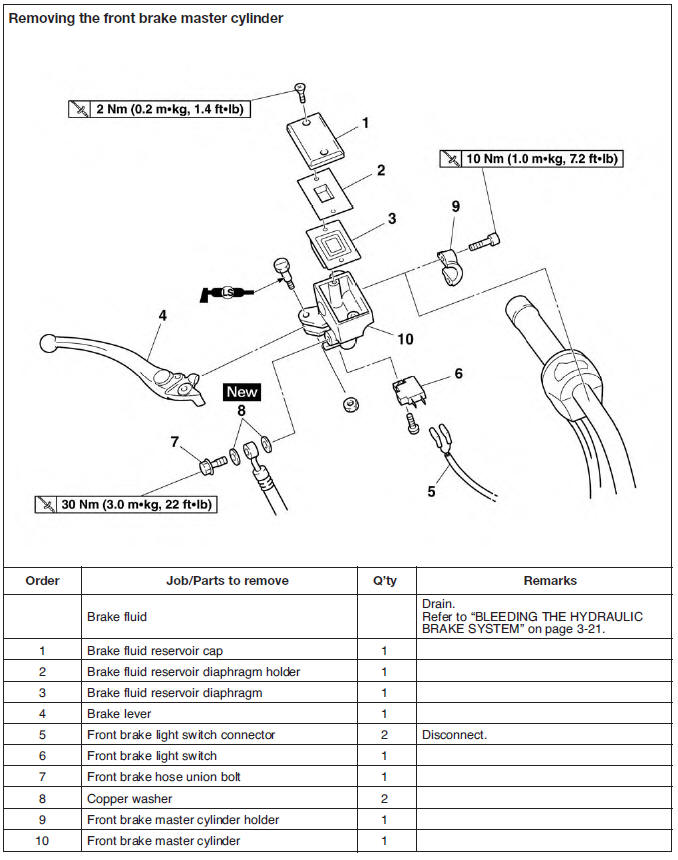


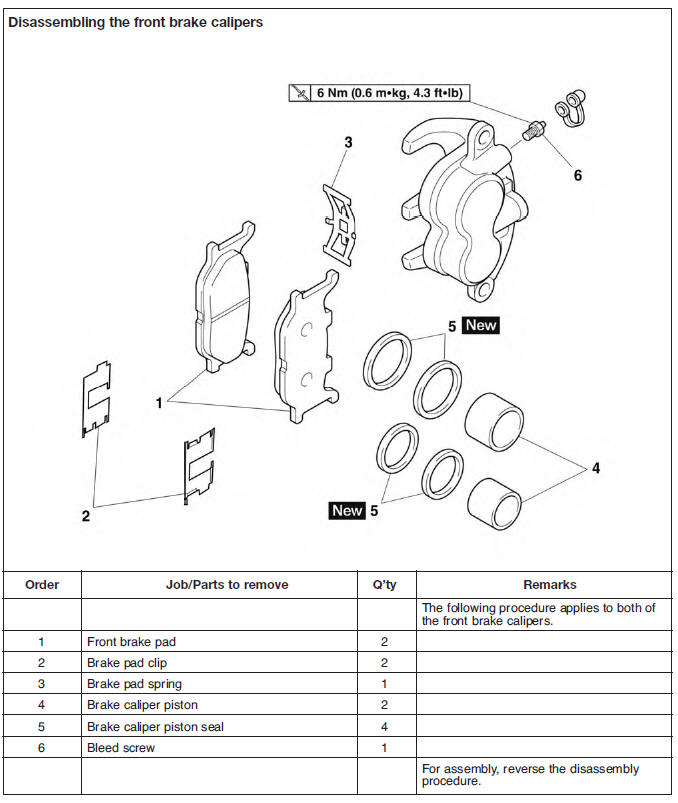
Introduction
WARNING
Disc brake components rarely require disassembly.
Therefore, always follow these preventive measures:
- Never disassemble brake components unless absolutely necessary.
- If any connection on the hydraulic brake system is disconnected, the entire brake system must be disassembled, drained, cleaned, properly filled, and bled after reassembly.
- Never use solvents on internal brake components.
- Use only clean or new brake fluid for cleaning brake components.
- Brake fluid may damage painted surfaces and plastic parts. Therefore, always clean up any spilt brake fluid immediately.
Avoid brake fluid coming into contact with the eyes as it can cause serious injury.
FIRST AID FOR BRAKE FLUID ENTERING THE EYES:
- Flush with water for 15 minutes and get immediate medical attention.
Checking the front brake discs
The following procedure applies to both brake discs.
1. Remove:
- Front wheel
2. Check:
- Brake disc
Damage/galling → Replace.
3. Measure:
- Brake disc deflection
Out of specification → Correct the brake disc deflection or replace the brake disc.
 Brake disc deflection limit
0.10 mm (0.0039 in)
Brake disc deflection limit
0.10 mm (0.0039 in)
a. Place the vehicle on a suitable stand so that the front wheel is elevated.
b. Before measuring the front brake disc deflection, turn the handlebar to the left or right to ensure that the front wheel is stationary.
c. Remove the brake caliper.
d. Hold the dial gauge at a right angle against the brake disc surface.
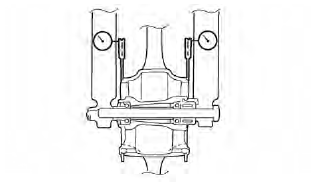
e. Measure the deflection 1.5 mm (0.06 in) below the edge of the brake disc.
4. Measure:
- Brake disc thickness
Measure the brake disc thickness at a few different locations.
Out of specification → Replace.
 Brake disc thickness limit
4.5 mm (0.18 in)
Brake disc thickness limit
4.5 mm (0.18 in)
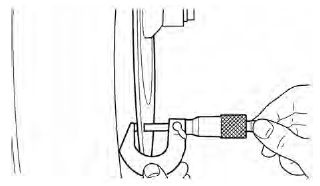
5. Adjust:
- Brake disc deflection
a. Remove the brake disc.
b. Rotate the brake disc by one bolt hole.
c. Install the brake disc.
 Front brake disc bolt
18 Nm (1.8 m*kg, 13 ft*lb)
LOCTITE
Front brake disc bolt
18 Nm (1.8 m*kg, 13 ft*lb)
LOCTITE
NOTE:
Tighten the brake disc bolts in stages and in a crisscross pattern.

d. Measure the brake disc deflection.
e. If out of specification, repeat the adjustment steps until the brake disc deflection is within specification.
f. If the brake disc deflection cannot be brought within specification, replace the brake disc.
6. Install:
- Front wheel
Replacing the front brake pads
The following procedure applies to both brake calipers.
NOTE:
When replacing the brake pads, it is not necessary to disconnect the brake hose or disassemble the brake caliper.
1. Measure:
- Brake pad wear limit "a"
Out of specification → Replace the brake pads as a set.
 Brake pad lining thickness
(inner)
Brake pad lining thickness
(inner)
6.0 mm (0.24 in)
Limit 0.8 mm (0.03 in)
Brake pad lining thickness (outer)
6.0 mm (0.24 in)
Limit 0.8 mm (0.03 in)
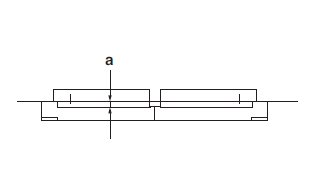
2. Install:
- Brake pad supports
- Brake pads
- Brake pad spring
NOTE:
Always install new brake pads and a brake pad spring as a set.
a. Connect a clear plastic hose "1" tightly to the bleed screw "2". Put the other end of the hose into an open container.
b. Loosen the bleed screw and push the brake caliper pistons into the brake caliper with your finger.

c. Tighten the bleed screw.
 Bleed
screw (front brake caliper)
6 Nm (0.6 m*kg, 4.3 ft*lb)
Bleed
screw (front brake caliper)
6 Nm (0.6 m*kg, 4.3 ft*lb)
d. Install new brake pads and a new brake pad spring.
3. Install:
- Front brake caliper
 Front brake caliper bolt
40 Nm (4.0 m*kg, 29 ft*lb)
Front brake caliper bolt
40 Nm (4.0 m*kg, 29 ft*lb)
4. Check:
- Brake fluid level
Below the minimum level mark "a" → Add the recommended brake fluid to the proper level.
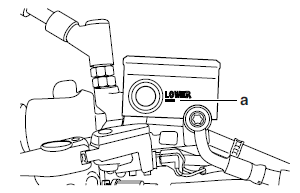
5. Check:
- Brake lever operation
Soft or spongy feeling → Bleed the brake system.
Removing the front brake calipers
The following procedure applies to both of the brake calipers.
NOTE:
Before removing the brake caliper, drain the brake fluid from the entire brake system.
1. Remove:
- Front brake hose union bolt "1"
- Copper washers "2"
- Front brake hose "3"
NOTE:
Put the end of the brake hose into a container and pump out the brake fluid carefully.
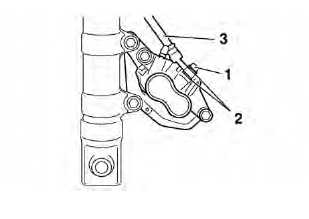
Disassembling the front brake calipers
The following procedure applies to both of the brake calipers.
1. Remove:
- Brake caliper pistons "1"
- Brake caliper piston seals "2"

a. Secure the right side brake caliper pistons with a piece of wood "a".
b. Blow compressed air into the brake hose joint opening "b" to force out the left side pistons from the brake caliper.
WARNING
- Cover the brake caliper piston with a rag.
Be careful not to get injured when the piston is expelled from the brake master cylinder.
- Never try to pry out the brake caliper piston.
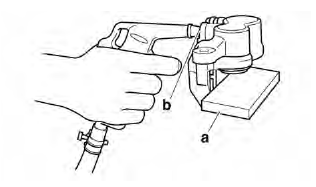
c. Remove the brake caliper piston seals.
Checking the front brake calipers

1. Check:
- Brake caliper pistons "1"
Rust/scratches/wear → Replace the brake caliper pistons.
- Brake caliper cylinders "2"
Scratches/wear → Replace the brake caliper assembly.
- Brake caliper body "3"
Cracks/damage → Replace the brake caliper assembly.
- Brake fluid delivery passages (brake caliper body)
Obstruction → Blow out with compressed air.
WARNING
Whenever a brake caliper is disassembled, replace the piston seals.

Assembling the front brake calipers
WARNING
- Before installation, all internal brake components should be cleaned and lubricated with clean or new brake fluid.
- Never use solvents on internal brake components as they will cause the piston seals to swell and distort.
- Whenever a brake caliper is disassembled, replace the brake caliper piston seals.
 Recommended fluid
DOT 4
Recommended fluid
DOT 4
Installing the front brake calipers
The following procedure applies to both of the brake calipers.
1. Install:
- Brake caliper bracket "1"
 Brake caliper bracket bolt
40 Nm (4.0 m*kg, 29 ft*lb)
Brake caliper bracket bolt
40 Nm (4.0 m*kg, 29 ft*lb)
- Brake pads
- Brake caliper "2"
 Brake caliper bolt
40 Nm (4.0 m*kg, 29 ft*lb)
Brake caliper bolt
40 Nm (4.0 m*kg, 29 ft*lb)
- Copper washers

- Front brake hose "3"
- Front brake hose union bolt "4"
 Front brake hose union bolt
30 Nm (3.0 m*kg, 22 ft*lb)
Front brake hose union bolt
30 Nm (3.0 m*kg, 22 ft*lb)
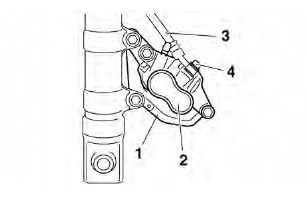
WARNING
Proper brake hose routing is essential to insure safe vehicle operation.
CAUTION:
When installing the brake hose onto the brake caliper "1", make sure the brake pipe "a" touches the projection "b" on the brake caliper.
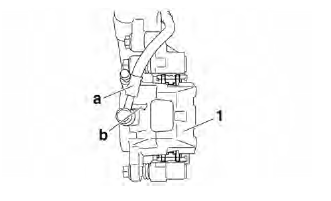
2. Fill:
- Brake fluid reservoir (with the specified amount of the recommended brake fluid)
 Recommended fluid
DOT 4
Recommended fluid
DOT 4
WARNING
- Use only the designated brake fluid. Other brake fluids may cause the rubber seals to deteriorate, causing leakage and poor brake performance.
- Refill with the same type of brake fluid that is already in the system. Mixing brake fluids may result in a harmful chemical reaction, leading to poor brake performance.
- When refilling, be careful that water does not enter the brake fluid reservoir. Water will significantly lower the boiling point of the brake fluid and could cause vapor lock.
CAUTION:
Brake fluid may damage painted surfaces and plastic parts. Therefore, always clean up any spilt brake fluid immediately.
3. Bleed:
- Brake system
4. Check:
- Brake fluid level
Below the minimum level mark "a" → Add the recommended brake fluid to the proper level.
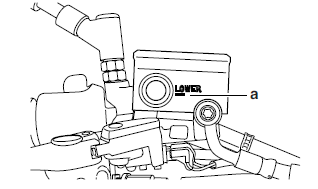
5. Check:
- Brake lever operation
Soft or spongy feeling → Bleed the brake system.
Removing the front brake master cylinder
NOTE:
Before removing the front brake master cylinder, drain the brake fluid from the entire brake system.
1. Disconnect:
- Brake light switch coupler (from the brake light switch)
2. Remove:
- Union bolt "1"
- Copper washers "2"
- Brake hose "3"
NOTE:
To collect any remaining brake fluid, place a container under the master cylinder and the end of the brake hose.

3. Remove:
- Brake lever
- Master cylinder bracket
- Master cylinder assembly
4. Remove:
- Circlip (from the master cylinder assembly)
- Master cylinder kit
Checking the front brake master cylinder
1. Check:
- Brake master cylinder "1" Damage/scratches/wear → Replace.
- Brake fluid delivery passages (brake master cylinder body) Obstruction → Blow out with compressed air.

2. Check:
- Brake master cylinder kit "1" Damage/scratches/wear → Replace.

3. Check:
- Brake fluid reservoir "1" Cracks/damage → Replace.
- Brake fluid reservoir diaphragm "2" Cracks/damage → Replace.

4. Check:
- Cracks/damage/wear → Replace.
Assembling the front brake master cylinder
WARNING
- Before installation, all internal brake components should be cleaned and lubricated with clean or new brake fluid.
- Never use solvents on internal brake components.
 Recommended fluid
DOT 4
Recommended fluid
DOT 4
Installing the front brake master cylinder
1. Install:
- Front brake master cylinder "1"
- Front brake master cylinder holder "2"
 Front brake master cylinder
holder bolt
10 Nm (1.0 m*kg, 7.2 ft*lb)
Front brake master cylinder
holder bolt
10 Nm (1.0 m*kg, 7.2 ft*lb)
NOTE:
- Install the brake master cylinder holder with the "UP" mark facing up.
- Align the end of the brake master cylinder holder with the punch mark "a" on the handlebar.
- First, tighten the upper bolt, then the lower bolt.

2. Install:
- Copper washers "1"

- Front brake hose "2"
- Front brake hose union bolt "3"
 Front brake hose union bolt
30 Nm (3.0 m*kg, 22 ft*lb)
Front brake hose union bolt
30 Nm (3.0 m*kg, 22 ft*lb)

WARNING
Proper brake hose routing is essential to insure safe vehicle operation.
CAUTION:
When installing the brake hose onto the brake master cylinder, make sure that the brake pipe touches the projection "a" on the brake master cylinder.
NOTE:
When installing the brake hose onto the brake master cylinder, make sure that the brake pipe touches the projection "a" on the brake master cylinder.
NOTE:
- While holding the brake hose, tighten the union bolt.
- Turn the handlebar to the left and right to
make sure the brake hose does not touch other
parts (e.g., wire harness, cables, leads).
Correct if necessary.
3. Fill:
- Brake fluid reservoir (with the specified amount of the recommended brake fluid)
 Recommended fluid
DOT 4
Recommended fluid
DOT 4
WARNING
- Use only the designated brake fluid. Other brake fluids may cause the rubber seals to deteriorate, causing leakage and poor brake performance.
- Refill with the same type of brake fluid that is already in the system. Mixing brake fluids may result in a harmful chemical reaction, leading to poor brake performance.
- When refilling, be careful that water does not enter the brake fluid reservoir. Water will significantly lower the boiling point of the brake fluid and could cause vapor lock.
CAUTION:
Brake fluid may damage painted surfaces and plastic parts. Therefore, always clean up any spilt brake fluid immediately.
4. Bleed:
- Brake system
5. Check:
- Brake fluid level
Below the minimum level mark "a" → Add the recommended brake fluid to the proper level.

6. Check:
- Brake lever operation
Soft or spongy feeling → Bleed the brake system.
See also:
 Yamaha MT-03 - Service manual > Front wheel
Yamaha MT-03 - Service manual > Front wheel
Removing the front wheel

 Benelli Imperiale 400
Benelli Imperiale 400 BMW F900XR
BMW F900XR Honda CB500X
Honda CB500X KTM 390 Adventure
KTM 390 Adventure Triumph Street Triple S
Triumph Street Triple S Yamaha MT-03
Yamaha MT-03 Kawasaki Z400
Kawasaki Z400 Triumph Street Triple S
Triumph Street Triple S Yamaha MT-03
Yamaha MT-03